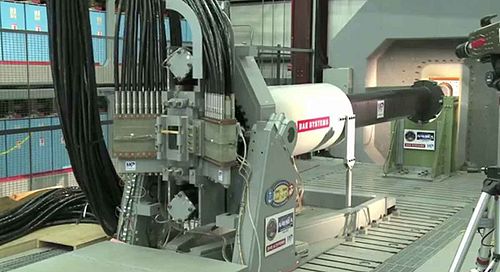Railgun: Difference between revisions
| Line 19: | Line 19: | ||
==Applications of Railguns== | ==Applications of Railguns== | ||
=== | ===The Navy=== | ||
As of now most the research, funding, and development for railgun weapons comes from the United States Navy. Phase I of the Electromagnetic Railgun Innovative Navy Project (INP) was started in 2005 with the goal of being able to create a 32 mega-joule muzzle energy device which has sense been completed. The Electromagnetic Railgun INP is now focussed on the advancements in technology which are needed for the weapon to operate at the 10-rounds-per-minute rate of fire that the Navy desires. The end goal is to have a kinetic energy weapon capable of a range of 100+ miles while also being able to reduce the amount of explosives on board the ship and decreasing the dangerous possibility of unexploded ordnance being left on the battlefield. | As of now most the research, funding, and development for railgun weapons comes from the United States Navy. Phase I of the Electromagnetic Railgun Innovative Navy Project (INP) was started in 2005 with the goal of being able to create a 32 mega-joule muzzle energy device which has sense been completed. The Electromagnetic Railgun INP is now focussed on the advancements in technology which are needed for the weapon to operate at the 10-rounds-per-minute rate of fire that the Navy desires. The end goal is to have a kinetic energy weapon capable of a range of 100+ miles while also being able to reduce the amount of explosives on board the ship and decreasing the dangerous possibility of unexploded ordnance being left on the battlefield. | ||
[[File:X43a2 nasa scramjet.jpg| | [[File:X43a2 nasa scramjet.jpg|350px|thumb|Artist's conception of the NASA X-43 with scramjet attached to the underside|alt=Artist's conception of black, wingless jet with pointed nose profile and two vertical stabilizers travelling high in the atmosphere.]] | ||
===NASA=== | ===NASA=== | ||
Revision as of 20:45, 5 December 2015
Claimed by fmaxwell6.
A railgun is used to launch conducting projectile at a high rate of velocity using only the forces deriving from electric and magnetic forces. The system is comprised of two parallel conducting "rails", a conducing projectile to be launched, and a battery to complete the circuit and to produce the current required to fire the projectile. Railguns are most often thought of as a type of kinetic energy weapon, meaning they use their momentum to create their destructive power instead of an explosive payload. While there are other types of kinetic energy weapons around today most of their speeds top out at Mach 3, where as a railgun theoretically could reach speeds in excess of Mach 10, however current prototypes are in more if the Mach 6 range.

The Main Idea
A railgun uses the principles of electromagnetics to create a weapon out of a conducting rod which is accelerated using the Lorentz Force in order to make the rod a projectile. The Lorentz Force combines the electrical force of a current carrying wire with the magnetic force coming from the the moving charged particles that make up the current in that wire.

A Mathematical Model
The Lorentz Force is the primary component in creating a railgun and is best know by the formula below:
[math]\displaystyle{ {F} = I\int \mathrm{d}\boldsymbol{\ell}\times{B} }[/math]
The direction of the force is found by using the right hand rule and pointing your hand in the direction of the current, folding your fingers in the direction of the magnetic field at that point, and then your thumb points in the direction of the force.
Applications of Railguns
As of now most the research, funding, and development for railgun weapons comes from the United States Navy. Phase I of the Electromagnetic Railgun Innovative Navy Project (INP) was started in 2005 with the goal of being able to create a 32 mega-joule muzzle energy device which has sense been completed. The Electromagnetic Railgun INP is now focussed on the advancements in technology which are needed for the weapon to operate at the 10-rounds-per-minute rate of fire that the Navy desires. The end goal is to have a kinetic energy weapon capable of a range of 100+ miles while also being able to reduce the amount of explosives on board the ship and decreasing the dangerous possibility of unexploded ordnance being left on the battlefield.

NASA
In order to find safer and less expensive means of space travel NASA has proposed the idea of launching payloads in to orbit using a two mile long railgun. The process would prove much safer for astronauts by taking out the highly explosive rocket fuel currently used to propel them into orbit, and for the same reason it would be a faction of the cost since the energy required would be significantly less. Another bonus is the flexibility that would be allowed. As opposed to current rockets which could never be launched on consecutive days, a railgun would allow another launch as soon as there was enough potential in the batteries.
Examples
Be sure to show all steps in your solution and include diagrams whenever possible
Simple
Middling
Difficult
Connectedness
- How is this topic connected to something that you are interested in?
- How is it connected to your major?
- Is there an interesting industrial application?
History
Put this idea in historical context. Give the reader the Who, What, When, Where, and Why.
See also
Are there related topics or categories in this wiki resource for the curious reader to explore? How does this topic fit into that context?
Further reading
Books, Articles or other print media on this topic
External links
References
http://www.onr.navy.mil/media-center/fact-sheets/electromagnetic-railgun.aspx
http://www.popsci.com/article/technology/navy-wants-fire-its-ridiculously-strong-railgun-ocean